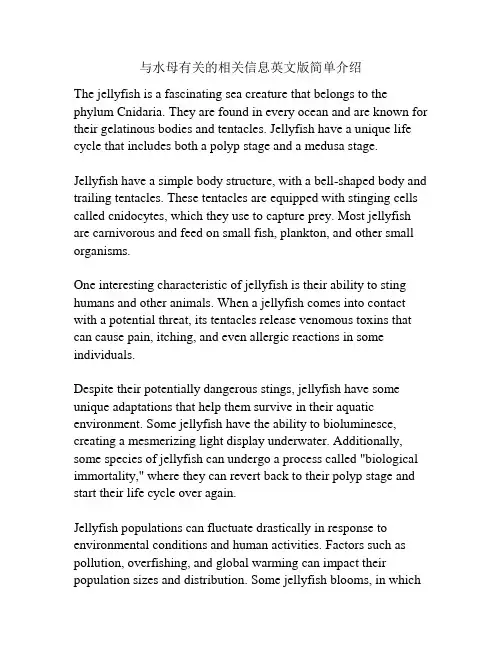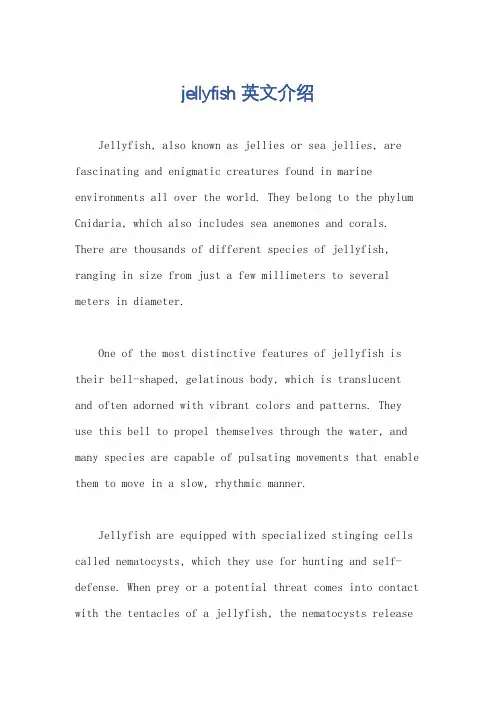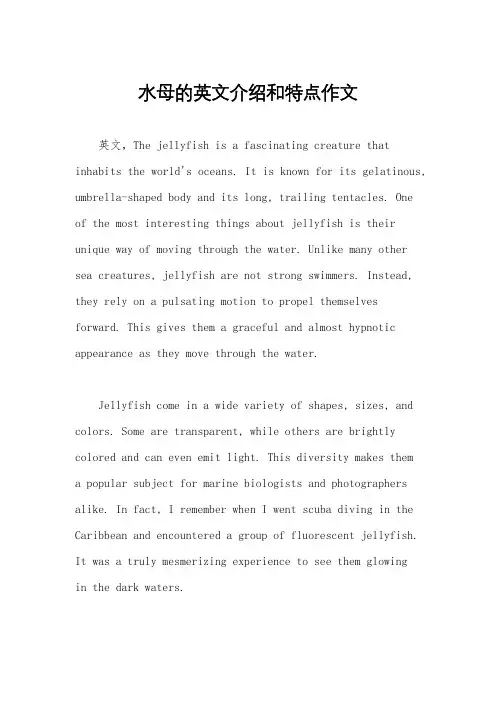JELLYFISH水母英文简介
- 格式:ppt
- 大小:4.91 MB
- 文档页数:13

介绍水母的作文英文,20词左右Jellyfish, enigmatic denizens of the ocean's depths, captivate and intrigue with their ethereal beauty and enigmatic nature. These gelatinous wonders, devoid of abrain or heart, possess an ancient lineage dating back millions of years, witnesses to the primordial dance oflife.Their diaphanous bodies, composed primarily of water, shimmer with an iridescent palette, reflecting the sunlight in a mesmerizing display. Their translucent forms, often adorned with intricate patterns and glowing bioluminescent organs, resemble underwater stained-glass windows.Jellyfish, despite their delicate appearance, are formidable predators. Their tentacles, armed with stinging cells called nematocysts, paralyze prey with a potent venom. These microscopic harpoons, triggered by touch or chemical stimuli, inject a neurotoxin that immobilizes the victim, allowing the jellyfish to engulf it whole.Their feeding strategy is as mesmerizing as it is efficient. Jellyfish glide effortlessly through the water, their pulsating bell propelling them with a gentle,rhythmic motion. Their tentacles, trailing gracefully behind, ensnare unsuspecting prey with remarkable precision.Beyond their captivating appearance and predatory prowess, jellyfish play a crucial role in marine ecosystems. As voracious consumers of plankton and small fish, they regulate populations and contribute to the delicate balance of the ocean's food chain.Furthermore, jellyfish are indicators of environmental health. Their sensitivity to changes in water temperature, salinity, and pollution levels make them valuable sentinels of marine ecosystems. Their presence or absence can provide insights into the health and stability of our oceans.The life cycle of jellyfish is as fascinating as their physical characteristics. They begin as tiny, free-swimming larvae called planulae. These microscopic organismseventually settle on the seabed and develop into polyps, resembling miniature sea anemones.Over time, polyps reproduce asexually, producing tiny buds that grow into juvenile jellyfish, known as ephyra. These immature jellyfish gradually develop into adult medusae, the familiar bell-shaped forms we encounter in the open ocean.The lifespan of jellyfish varies greatly depending on the species. Some, like the immortal jellyfish, possess the remarkable ability to revert to a polyp stage after reaching sexual maturity, potentially achieving biological immortality.Jellyfish have captured the imagination of humans for centuries. Ancient mariners saw them as ill omens, harbingers of storms and misfortune. In contrast, modern scientists marvel at their resilience, adaptability, and ecological significance.Today, jellyfish continue to enchant and inspire. Theyhave become subjects of scientific research, artistic expression, and environmental conservation efforts. Their ethereal beauty, enigmatic nature, and ecological importance make them enduring symbols of the wonders that lie beneath the ocean's surface.。

与水母有关的相关信息英文版简单介绍The jellyfish is a fascinating sea creature that belongs to the phylum Cnidaria. They are found in every ocean and are known for their gelatinous bodies and tentacles. Jellyfish have a unique life cycle that includes both a polyp stage and a medusa stage.Jellyfish have a simple body structure, with a bell-shaped body and trailing tentacles. These tentacles are equipped with stinging cells called cnidocytes, which they use to capture prey. Most jellyfish are carnivorous and feed on small fish, plankton, and other small organisms.One interesting characteristic of jellyfish is their ability to sting humans and other animals. When a jellyfish comes into contact with a potential threat, its tentacles release venomous toxins that can cause pain, itching, and even allergic reactions in some individuals.Despite their potentially dangerous stings, jellyfish have some unique adaptations that help them survive in their aquatic environment. Some jellyfish have the ability to bioluminesce, creating a mesmerizing light display underwater. Additionally, some species of jellyfish can undergo a process called "biological immortality," where they can revert back to their polyp stage and start their life cycle over again.Jellyfish populations can fluctuate drastically in response to environmental conditions and human activities. Factors such as pollution, overfishing, and global warming can impact their population sizes and distribution. Some jellyfish blooms, in whichlarge numbers of jellyfish gather in one area, can be harmful to the ecosystem as they can compete with other marine organisms for resources.Overall, jellyfish are intriguing creatures that play important roles in marine ecosystems. Despite their sting, they offer a unique insight into the complexities of ocean life.。

jellyfish英文介绍Jellyfish, also known as jellies or sea jellies, are fascinating and enigmatic creatures found in marine environments all over the world. They belong to the phylum Cnidaria, which also includes sea anemones and corals. There are thousands of different species of jellyfish, ranging in size from just a few millimeters to several meters in diameter.One of the most distinctive features of jellyfish is their bell-shaped, gelatinous body, which is translucent and often adorned with vibrant colors and patterns. They use this bell to propel themselves through the water, and many species are capable of pulsating movements that enable them to move in a slow, rhythmic manner.Jellyfish are equipped with specialized stinging cells called nematocysts, which they use for hunting and self-defense. When prey or a potential threat comes into contact with the tentacles of a jellyfish, the nematocysts releasetiny, barbed harpoons that inject venom into the target. While most jellyfish stings are not fatal to humans, they can cause discomfort, pain, and in some cases, more severe reactions.These mesmerizing creatures play an important role in marine ecosystems. They are opportunistic feeders, consuming small fish, plankton, and other jellyfish. In turn, they serve as prey for various marine animals, including sea turtles and certain species of fish.Jellyfish are also known for their unique life cycle, which typically includes a polyp stage and a medusa stage. During the polyp stage, they resemble small, cylindrical organisms attached to the seafloor or other surfaces. In the medusa stage, they take on their characteristic bell-shaped form and become free-swimming.In recent years, jellyfish populations have experienced fluctuations and blooms in various parts of the world, leading to concerns about their potential impact on human activities such as fishing and tourism. Climate change,overfishing, and pollution are among the factors that may contribute to these fluctuations.Overall, jellyfish are captivating creatures with a rich evolutionary history and a significant presence in marine ecosystems. Studying them can provide valuable insights into the dynamics of oceanic environments and the intricate web of life that exists within them.。

英文带翻译描述水母Jellyfish: The Mysterious Creatures of the Ocean。
水母,海洋中神秘的生物。
Jellyfish are fascinating creatures that inhabit the world's oceans. They are known for their gelatinous bodies and long, flowing tentacles, which can deliver a painful sting to their prey or even to humans. Despite their simple appearance, jellyfish are actually complex creatures with unique adaptations that allow them to survive in a variety of environments.水母是生活在世界各大海洋中的迷人生物。
它们以其胶状的身体和长长的触手而闻名,这些触手可以对其猎物甚至人类造成疼痛的刺痛。
尽管水母看起来很简单,但它们实际上是复杂的生物,具有独特的适应性,使它们能够在各种环境中生存。
Jellyfish belong to the phylum Cnidaria, which also includes corals and sea anemones. They are characterized bytheir radial symmetry and stinging cells called nematocysts, which are used for self-defense and capturing prey.Jellyfish come in a variety of shapes and sizes, ranging from tiny, almost invisible creatures to large, umbrella-shaped species that can grow up to several meters in diameter.水母属于刺胞动物门,这个门还包括珊瑚和海葵。

水母的英文介绍和特点作文英文,The jellyfish is a fascinating creature that inhabits the world's oceans. It is known for its gelatinous, umbrella-shaped body and its long, trailing tentacles. Oneof the most interesting things about jellyfish is their unique way of moving through the water. Unlike many other sea creatures, jellyfish are not strong swimmers. Instead, they rely on a pulsating motion to propel themselves forward. This gives them a graceful and almost hypnotic appearance as they move through the water.Jellyfish come in a wide variety of shapes, sizes, and colors. Some are transparent, while others are brightly colored and can even emit light. This diversity makes thema popular subject for marine biologists and photographers alike. In fact, I remember when I went scuba diving in the Caribbean and encountered a group of fluorescent jellyfish. It was a truly mesmerizing experience to see them glowingin the dark waters.One of the most unique features of jellyfish is their ability to sting. Their tentacles are lined with tiny, stinging cells called nematocysts, which they use to capture prey and defend themselves from predators. I once got stung by a jellyfish while swimming in the ocean, and let me tell you, it was not a pleasant experience. The pain was intense and lasted for hours. It was a good reminder of just how powerful and dangerous these creatures can be.中文,水母是一种生活在世界各大洋的迷人生物。

Jellyfish: The Mysterious Creatures of the OceanThe jellyfish, a fascinating and mysterious creature of the deep, has captivated the imagination of many with its ethereal beauty and unique form. These transparent marine invertebrates are often found floating gracefully through the ocean's currents, their bell-like bodies pulsating rhythmically.The jellyfish's body structure is unlike any other creature in the ocean. It lacks a distinct head, tail, or internal skeleton, relying instead on a gelatinous bell that houses its vital organs. These organs, including the mouth, manubrium, and gonads, are tucked away within the bell's translucent walls. The jellyfish's tentacles, which can extend from the bell's perimeter, are equipped with stinging cells that are used to capture prey or deter predators.The jellyfish's life cycle is equally intriguing. Many jellyfish species begin their lives as tiny larvae, known as planula, which float in the ocean currents until they find a suitable place to settle and transform into polyps. These polyps, anchored to the seabed or other surfaces, grow and eventually bud off new jellyfish that are ready to enter the water column and begin their own independent lives.Despite their delicate appearance, jellyfish are surprisingly resilient creatures. They have survived for millions of years, adapting to various environments and evolving unique mechanisms to ensure their survival. For instance, some jellyfish species are able to reproduce asexually, creating clones of themselves that inherit their genetic traits. This allows them to quickly populate new habitats and thrive in changing environments.However, jellyfish can also pose a threat to humans and marine ecosystems. Blooms of jellyfish, known as "jellyfish swarms," can disrupt fishing operations and damage coastal infrastructure. In addition, the stinging cells on their tentacles can cause painful and sometimes dangerous reactions when humans come into contact with them.Despite these challenges, jellyfish remain an integral part of the ocean's ecosystem. They play an important role in the food chain, serving as prey for larger predators like sea turtles and some species of fish. Furthermore, their transparent bodies allow scientists to study ocean currents and other environmental factors that are difficult to observe directly.In conclusion, the jellyfish is a fascinating creature that continues to inspire curiosity and wonder. Its unique body structure, intriguing life cycle, and resilience in the face of adversity make it a truly remarkable addition to the ocean's diverse ecosystem.。

介绍水母的英文作文英文,。
Jellyfish, also known as jellies, are fascinating creatures that can be found in oceans all over the world. They are not actually fish, but rather belong to the phylum Cnidaria, which also includes corals and sea anemones. 。
Jellyfish have a unique anatomy, consisting of a bell-shaped body and long, trailing tentacles. These tentacles are lined with stinging cells called nematocysts, which the jellyfish uses to capture its prey. 。
One interesting fact about jellyfish is that they have no brain, heart, or blood. Instead, they have a simple nervous system that allows them to sense their environment and respond to stimuli. 。
There are many different species of jellyfish, each with their own unique characteristics. Some, like the boxjellyfish, are highly venomous and can be dangerous to humans. Others, like the moon jellyfish, are harmless and are often kept in aquariums. 。

英语介绍水母的作文Title: The Enigmatic Beauty of Jellyfish。
Jellyfish, often regarded as enigmatic creatures of the ocean, hold a unique place in the marine ecosystem. Their graceful movements and mesmerizing appearance have captivated the imagination of many. In this essay, we delve into the fascinating world of jellyfish, exploring their characteristics, ecological significance, and the challenges they face.Introduction:Jellyfish, belonging to the phylum Cnidaria, are ancient inhabitants of the ocean, with a lineage dating back millions of years. Their simple yet elegant design comprises a gelatinous bell-shaped body and trailing tentacles armed with stinging cells called nematocysts.Physical Characteristics:The anatomy of jellyfish is a marvel of efficiency and simplicity. Their translucent bodies, often pulsating gently, lend them an ethereal quality as they drift with the currents. While their appearance may seem delicate, jellyfish are remarkably resilient creatures, adapting to a wide range of marine environments.Ecological Role:Despite their seemingly passive nature, jellyfish play a crucial role in marine ecosystems. They serve as both predators and prey, contributing to the intricate web of life beneath the waves. Jellyfish feed on small fish, plankton, and even other jellyfish, helping to control population levels and maintain ecological balance. Additionally, their nutrient-rich bodies provide sustenance for numerous marine species, from turtles to certain types of fish.Challenges and Adaptations:In recent years, jellyfish populations have been experiencing fluctuations, with some species exhibiting blooms of unprecedented scale. These blooms, often fueled by human-induced factors such as overfishing, pollution, and climate change, can have significant ecological and economic impacts. For example, large jellyfish swarms can clog fishing nets, disrupt tourism, and even damage power plant intakes.To survive in an ever-changing oceanic environment, jellyfish have developed remarkable adaptations. Their ability to thrive in low-oxygen zones and tolerate varying salinity levels allows them to occupy niches where other marine organisms struggle to survive. Furthermore, some jellyfish species exhibit a phenomenon known as "polyp bailout," where they revert to a juvenile stage to escape unfavorable conditions, ensuring the continuation of their lineage.Conservation and Awareness:Protecting jellyfish and their habitats is essentialfor maintaining the health of marine ecosystems. Efforts to mitigate the factors driving jellyfish blooms require international collaboration and a multifaceted approach. Educating the public about the ecological importance of jellyfish and promoting sustainable practices in fisheries and coastal development are crucial steps towards achieving this goal.Conclusion:In conclusion, jellyfish are more than just ethereal creatures drifting through the ocean currents; they are integral components of marine ecosystems, embodying resilience and adaptability in the face of environmental challenges. By understanding and appreciating the intricate role that jellyfish play, we can work towards ensuring a balanced and thriving ocean for generations to come.。

水母的简单介绍英文作文英文:Jellyfish are fascinating creatures that can be found in oceans all over the world. They are not actually fish, but are classified as invertebrates, which means that they don't have a backbone. Instead, they have a gelatinous body that is made up of 95% water.Jellyfish come in many different shapes and sizes, from tiny ones that are only a few millimeters in diameter to giant ones that can be over two meters long. Some species of jellyfish have long, flowing tentacles that can be used to capture prey, while others have short, stubby tentacles that are used for defense.One of the most interesting things about jellyfish is their ability to glow in the dark. This is due to a process called bioluminescence, which is the production and emission of light by a living organism. Some species ofjellyfish are able to produce their own light, while others are able to reflect light that is already present in their environment.Despite their beauty, jellyfish can be dangerous to humans. Some species have stinging tentacles that can cause painful and even deadly reactions. It is important to be cautious when swimming in areas where jellyfish are knownto live.Overall, jellyfish are fascinating creatures that are worth learning about. They play an important role in the marine ecosystem and have unique adaptations that allowthem to survive in their environment.中文:水母是一种迷人的生物,可以在全世界的海洋中找到。

水母外貌英文介绍作文The jellyfish is a fascinating creature with a unique appearance. Its transparent, gelatinous body and long, flowing tentacles make it a mesmerizing sight to behold.The jellyfish's body is made up of a soft, umbrella-shaped bell, which pulsates to propel it through the water. Its long, trailing tentacles are covered in stinging cells, which it uses to capture prey and defend itself from predators.One of the most striking features of the jellyfish is its bioluminescence. When disturbed or threatened, it can emit a beautiful, glowing light, creating a stunning visual display in the dark depths of the ocean.Despite its delicate appearance, the jellyfish is a highly efficient predator. It feeds on small fish, shrimp, and other tiny organisms that become ensnared in itstrailing tentacles.The jellyfish's appearance may be otherworldly, but it plays a crucial role in the marine ecosystem. As both predator and prey, it helps to maintain the balance ofocean life.In conclusion, the jellyfish's ethereal appearance and unique characteristics make it a truly captivating creature. Its role in the marine ecosystem, combined with its mesmerizing beauty, makes it a subject of endlessfascination and study.。

海月水母英文作文英文回答:Jellyfish, also known as sea jellies, are fascinating creatures that inhabit the world's oceans. They belong to the phylum Cnidaria and are known for their gelatinous bodies and stinging tentacles. Jellyfish come in a variety of shapes and sizes, ranging from small and transparent to large and colorful.One interesting fact about jellyfish is their ability to sting. They have specialized cells called cnidocytes that contain nematocysts, which are tiny harpoon-like structures. When a jellyfish comes into contact with its prey or a potential threat, it uses its tentacles to release the nematocysts and inject venom into its target. This venom can cause pain, redness, and even paralysis in humans.Another fascinating aspect of jellyfish is their lifecycle. They start off as tiny larvae called planulae, which float in the water until they find a suitable surface to attach themselves to. Once attached, they develop into polyps, which resemble small sea anemones. The polyps then reproduce asexually by budding, creating genetically identical medusae, or adult jellyfish. These medusae arethe ones we commonly see swimming in the ocean.Jellyfish play an important role in marine ecosystems. They are opportunistic predators, feeding on small fish, plankton, and other invertebrates. By controlling the population of these organisms, jellyfish help maintain the balance of the food chain. Additionally, jellyfish themselves serve as a food source for larger marine animals, such as sea turtles and certain species of fish.Despite their ecological significance, jellyfish canalso be a nuisance to humans. They can form massive blooms, known as jellyfish swarms or blooms, which can havenegative impacts on fisheries, tourism, and even power plants. For example, jellyfish swarms can clog fishing nets, making it difficult for fishermen to catch fish. They canalso sting swimmers and beachgoers, causing discomfort and sometimes even allergic reactions.In conclusion, jellyfish are intriguing creatures that have both positive and negative impacts on the marine environment and human activities. They have unique adaptations, such as their stinging tentacles and complexlife cycle. While they play a vital role in marine ecosystems, they can also pose challenges for industriesand individuals. Understanding and managing jellyfish populations is crucial for maintaining the health of our oceans.中文回答:海月水母,也被称为水母,是栖息在世界各大洋中的迷人生物。
水母的介绍和特点100字作文英文回答,Jellyfish, also known as medusas, are fascinating marine creatures. They belong to the phylum Cnidaria and are found in every ocean of the world. Jellyfish have a unique body structure with a gelatinous bell-shaped body and long trailing tentacles. These tentacles are covered in specialized cells called cnidocytes, which contain venomous stinging structures called nematocysts.Jellyfish have a simple nervous system and lack a brain or centralized control system. They rely on their sensory organs to detect food and danger. Most jellyfish are carnivorous and feed on small fish, plankton, and other marine organisms. They capture their prey by paralyzing them with their venomous tentacles and then bring them towards their mouth.One of the most distinctive features of jellyfish is their ability to undergo a life cycle that involves bothsexual and asexual reproduction. They can reproduce either by releasing eggs and sperm into the water for external fertilization or by budding off medusae from their polyp stage. This unique reproductive strategy allows jellyfish populations to rapidly increase under favorable conditions.Jellyfish are also known for their bioluminescence, which means they can produce light. This light productionis used for various purposes, such as attracting prey or potential mates. Some jellyfish species even have theability to change their color or pattern to blend in with their surroundings or to scare away predators.中文回答,水母,又被称为海蜇,是一种迷人的海洋生物。
水母的科普英文作文英文:Water jellyfish, also known as jellyfish, are marine invertebrates that belong to the phylum Cnidaria. They are found in all the world's oceans, from the surface to the deep sea. Their body is composed of a bell-shaped or umbrella-shaped structure, which is called the medusa. Water jellyfish have tentacles that are used for capturing prey, which they then eat with their mouth located underneath their bell.One interesting fact about water jellyfish is that they do not have a brain or a central nervous system. Instead, they have a simple network of nerves that allows them to sense their surroundings and respond to stimuli. This network of nerves is called a nerve net.Water jellyfish are also known for their ability to glow in the dark. This is due to the presence ofbioluminescent proteins in their body. When these proteins are triggered by certain stimuli, such as movement or touch, they emit a bright light that can be seen in the water.Water jellyfish can be harmful to humans, as their tentacles can deliver a painful sting. However, not all species of water jellyfish are harmful to humans, and some are even used in traditional medicine for their healing properties.中文:水母,也被称为海蜇,是属于刺胞动物门的海洋无脊椎动物。
用英语写水母作文怎么写Jellyfish, also known as sea jellies, are fascinating creatures that are found in oceans all over the world. They are a type of planktonic animal and are not actually fish at all. Jellyfish are known for their gelatinous appearance and their ability to sting. In this essay, we will explore the anatomy, behavior, and importance of jellyfish.Anatomy。
Jellyfish are made up of a bell-shaped body that is composed of a soft, gelatinous material called mesoglea. This material is made up of water, protein, and other substances. The bell is surrounded by tentacles that are used for capturing food and for protection. Jellyfish also have a simple nervous system that allows them to detect light, touch, and chemicals in the water.Behavior。
Jellyfish are known for their ability to sting. They have specialized cells called nematocysts that are used for defense and for capturing prey. When a jellyfish comes into contact with another animal, the nematocysts release atoxin that can cause pain, itching, and sometimes even death. Some species of jellyfish are more dangerous than others, and it is important to avoid contact with them.Jellyfish are also known for their unique swimming behavior. They use a pulsing motion to move through the water, and they can swim in any direction. This allows them to move freely and to capture food more easily.Importance。
介绍水母英文故事作文Water jellyfish, also known as jellyfish, are fascinating creatures that live in the ocean. They have a gelatinous, umbrella-shaped bell and long, trailing tentacles. These tentacles are equipped with stinging cells to capture prey and defend against predators. The beauty of water jellyfish lies in their graceful movements as they drift through the water.Water jellyfish come in a variety of colors, including pink, blue, and transparent. Some species even have bioluminescent abilities, meaning they can produce their own light. This makes them a mesmerizing sight to behold, especially in the dark depths of the ocean.Despite their delicate appearance, water jellyfish are actually quite resilient creatures. They have been around for millions of years and have adapted to various environmental changes. This resilience allows them tothrive in different oceanic conditions, from the Arctic tothe tropics.One of the most fascinating aspects of water jellyfishis their unique life cycle. They start as tiny larvae, then grow into polyps, and finally develop into the familiarbell-shaped jellyfish. This transformation is a marvel of nature and adds to the mystique surrounding these creatures.Water jellyfish play an important role in the marine ecosystem. They are a food source for various marine animals, including sea turtles and some species of fish. Additionally, their presence in the ocean helps to maintain the balance of marine populations.Unfortunately, water jellyfish are also known for their ability to form large swarms, or blooms, in certain partsof the ocean. These blooms can have negative impacts on the environment and human activities, such as clogging fishing nets and disrupting power plants.Despite the challenges they may pose, water jellyfish continue to captivate and intrigue people around the world.Their ethereal beauty and mysterious nature make them a symbol of the wonders of the ocean. Whether you encounter them in an aquarium or out in the open sea, water jellyfish are sure to leave a lasting impression.。
关于水母的英语介绍英文回答:Jellyfish are marine invertebrates that are found inall the world's oceans. They are part of the phylum Cnidaria, which also includes corals, sea anemones, and hydras. Jellyfish are characterized by their gelatinous bodies and radial symmetry. They have a bell-shaped or umbrella-shaped body with a central cavity called the gastrovascular cavity. The gastrovascular cavity is usedfor both digestion and circulation. Jellyfish have tentacles around the edge of their body that are used to capture prey.Jellyfish are predators and feed on a variety of small aquatic animals, including plankton, fish larvae, and crustaceans. They use their tentacles to capture prey and then use their mouths to ingest it. Jellyfish have a simple digestive system and the food is digested in the gastrovascular cavity.Jellyfish are able to move through the water by contracting their bell-shaped or umbrella-shaped body. This creates a jet of water that propels the jellyfish forward. Jellyfish can also use their tentacles to swim.Jellyfish are an important part of the marine ecosystem. They are a food source for other marine animals, such as fish, sea turtles, and dolphins. Jellyfish also help to clean the water by removing plankton and other small organisms.Some jellyfish can be dangerous to humans. The box jellyfish, for example, can deliver a fatal sting. However, most jellyfish are not dangerous to humans and can be enjoyed by swimmers and snorkelers.中文回答:水母是一种海洋无脊椎动物,分布于世界所有海洋中。
水母的介绍英文作文下载温馨提示:该文档是我店铺精心编制而成,希望大家下载以后,能够帮助大家解决实际的问题。
文档下载后可定制随意修改,请根据实际需要进行相应的调整和使用,谢谢!并且,本店铺为大家提供各种各样类型的实用资料,如教育随笔、日记赏析、句子摘抄、古诗大全、经典美文、话题作文、工作总结、词语解析、文案摘录、其他资料等等,如想了解不同资料格式和写法,敬请关注!Download tips: This document is carefully compiled by theeditor. I hope that after you download them,they can help yousolve practical problems. The document can be customized andmodified after downloading,please adjust and use it according toactual needs, thank you!In addition, our shop provides you with various types ofpractical materials,such as educational essays, diaryappreciation,sentence excerpts,ancient poems,classic articles,topic composition,work summary,word parsing,copyexcerpts,other materials and so on,want to know different data formats andwriting methods,please pay attention!Jellyfish are really interesting creatures. They float around in the water like little ghosts.You know, jellyfish can be really beautiful. Some of them have these amazing colors and patterns.But be careful around them! They can sting and it can hurt.Jellyfish are kind of mysterious. We still don't know everything about them.They just exist in the ocean, doing their own thing. It's kind of cool to think about.。